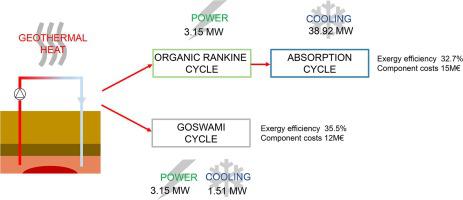当前位置:
X-MOL 学术
›
Energy Convers. Manag.
›
论文详情
Our official English website, www.x-mol.net, welcomes your feedback! (Note: you will need to create a separate account there.)
Energy, exergy, and cost comparison of Goswami cycle and cascade organic Rankine cycle/absorption chiller system for geothermal application
Energy Conversion and Management ( IF 10.4 ) Pub Date : 2021-01-01 , DOI: 10.1016/j.enconman.2020.113598 Martina Leveni , Raffaello Cozzolino
Energy Conversion and Management ( IF 10.4 ) Pub Date : 2021-01-01 , DOI: 10.1016/j.enconman.2020.113598 Martina Leveni , Raffaello Cozzolino

|
Abstract Combined cooling and power production can improve the overall efficiency of a geothermal energy conversion system. Most systems have complex structures, characterized by a large number of devices resulting in a greater heat loss, low energy conversion efficiency and higher costs. This paper presents a geothermal system based on a modified Goswami cycle, aimed to produce cooling and power simultaneously in one loop. The proposed system has a simple structure with few components, and the heat rejected to the environment by the rectifier is internally recovered to preheat the strong solution, involving lower heat losses and higher conversion efficiencies. In order to investigate the exergy destructions and losses, the overall performances, and the total absolute component cost, the modeling of the proposed system is established in detail. The Goswami system performance is evaluated for the conditions of an actual application, the geothermal reservoir of Torre Alfina (Italy), and the results compared with those of a cascade system based on organic Rankine cycle coupled with a water/lithium bromide absorption chiller. Results show that for the same power output produced in both systems, the best scenario is the Goswami cycle system with an exergy efficiency of 35.53% against 32.77% of the cascade system case. In addition, the component cost analysis showed that the highest total absolute component cost is obtained for the cascade system case with a total of 14.6 M€, while the Goswami case showed a lower value with a total of 11.8 M€.
中文翻译:

用于地热应用的 Goswami 循环和级联有机朗肯循环/吸收式制冷系统的能源、火用和成本比较
摘要 冷电联产可以提高地热能转换系统的整体效率。大多数系统结构复杂,设备数量多,热损失大,能量转换效率低,成本高。本文介绍了一种基于改良 Goswami 循环的地热系统,旨在在一个循环中同时产生冷却和电力。所提出的系统结构简单,组件少,整流器散发到环境中的热量在内部回收以预热强溶液,涉及较低的热损失和较高的转换效率。为了研究火用破坏和损失、整体性能和总绝对组件成本,详细建立了所提出系统的建模。Goswami 系统性能根据实际应用条件、Torre Alfina(意大利)的地热储层进行评估,并将结果与基于有机朗肯循环和水/溴化锂吸收式制冷机的级联系统的结果进行比较。结果表明,对于在两个系统中产生的相同功率输出,最佳方案是 Goswami 循环系统,其火用效率为 35.53%,而级联系统情况为 32.77%。此外,组件成本分析表明,级联系统案例获得的总绝对组件成本最高,为 1460 万欧元,而 Goswami 案例的价值较低,为 1180 万欧元。并将结果与基于有机朗肯循环和水/溴化锂吸收式制冷机的级联系统的结果进行比较。结果表明,对于在两个系统中产生的相同功率输出,最佳方案是 Goswami 循环系统,其火用效率为 35.53%,而级联系统情况为 32.77%。此外,组件成本分析表明,级联系统案例获得的总绝对组件成本最高,为 1460 万欧元,而 Goswami 案例的价值较低,为 1180 万欧元。并将结果与基于有机朗肯循环和水/溴化锂吸收式制冷机的级联系统的结果进行比较。结果表明,对于在两个系统中产生的相同功率输出,最佳方案是 Goswami 循环系统,其火用效率为 35.53%,而级联系统情况为 32.77%。此外,组件成本分析表明,级联系统案例获得的总绝对组件成本最高,为 1460 万欧元,而 Goswami 案例的价值较低,为 1180 万欧元。77% 的级联系统案例。此外,组件成本分析表明,级联系统案例获得的总绝对组件成本最高,为 1460 万欧元,而 Goswami 案例的价值较低,为 1180 万欧元。77% 的级联系统案例。此外,组件成本分析表明,级联系统案例获得的总绝对组件成本最高,为 1460 万欧元,而 Goswami 案例的价值较低,为 1180 万欧元。
更新日期:2021-01-01
中文翻译:

用于地热应用的 Goswami 循环和级联有机朗肯循环/吸收式制冷系统的能源、火用和成本比较
摘要 冷电联产可以提高地热能转换系统的整体效率。大多数系统结构复杂,设备数量多,热损失大,能量转换效率低,成本高。本文介绍了一种基于改良 Goswami 循环的地热系统,旨在在一个循环中同时产生冷却和电力。所提出的系统结构简单,组件少,整流器散发到环境中的热量在内部回收以预热强溶液,涉及较低的热损失和较高的转换效率。为了研究火用破坏和损失、整体性能和总绝对组件成本,详细建立了所提出系统的建模。Goswami 系统性能根据实际应用条件、Torre Alfina(意大利)的地热储层进行评估,并将结果与基于有机朗肯循环和水/溴化锂吸收式制冷机的级联系统的结果进行比较。结果表明,对于在两个系统中产生的相同功率输出,最佳方案是 Goswami 循环系统,其火用效率为 35.53%,而级联系统情况为 32.77%。此外,组件成本分析表明,级联系统案例获得的总绝对组件成本最高,为 1460 万欧元,而 Goswami 案例的价值较低,为 1180 万欧元。并将结果与基于有机朗肯循环和水/溴化锂吸收式制冷机的级联系统的结果进行比较。结果表明,对于在两个系统中产生的相同功率输出,最佳方案是 Goswami 循环系统,其火用效率为 35.53%,而级联系统情况为 32.77%。此外,组件成本分析表明,级联系统案例获得的总绝对组件成本最高,为 1460 万欧元,而 Goswami 案例的价值较低,为 1180 万欧元。并将结果与基于有机朗肯循环和水/溴化锂吸收式制冷机的级联系统的结果进行比较。结果表明,对于在两个系统中产生的相同功率输出,最佳方案是 Goswami 循环系统,其火用效率为 35.53%,而级联系统情况为 32.77%。此外,组件成本分析表明,级联系统案例获得的总绝对组件成本最高,为 1460 万欧元,而 Goswami 案例的价值较低,为 1180 万欧元。77% 的级联系统案例。此外,组件成本分析表明,级联系统案例获得的总绝对组件成本最高,为 1460 万欧元,而 Goswami 案例的价值较低,为 1180 万欧元。77% 的级联系统案例。此外,组件成本分析表明,级联系统案例获得的总绝对组件成本最高,为 1460 万欧元,而 Goswami 案例的价值较低,为 1180 万欧元。



























 京公网安备 11010802027423号
京公网安备 11010802027423号